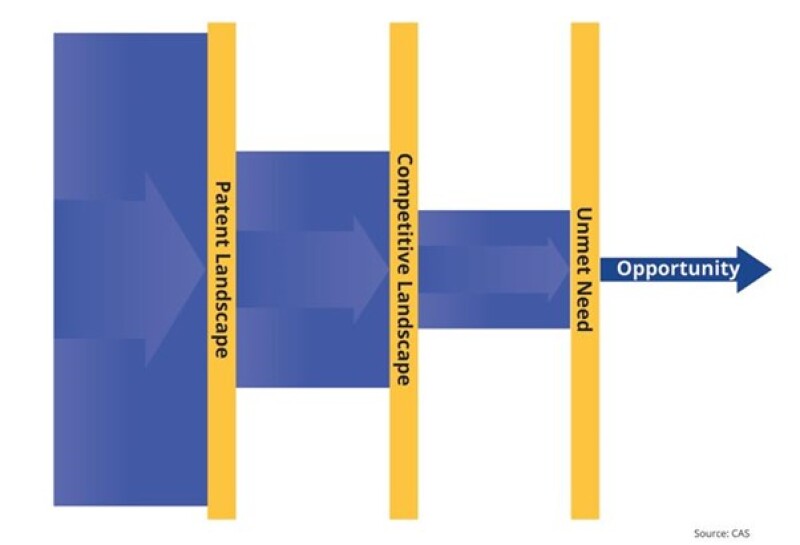In today's competitive market, R&D teams are constantly looking for new opportunities to drive innovation and stay ahead of the curve. However, the sheer volume of information makes it challenging to identify promising areas for development and avoid wasting resources on unproductive pursuits. This is where a patent landscape analysis can be incredibly valuable.
Patent landscape analysis: what’s involved
This process involves digging deep into the technology landscape of a particular industry or field to gain a comprehensive understanding of what is out there. A patent landscape analysis involves reviewing the patents and scientific literature related to a specific area of research. By examining recent developments over the past few years, organisations can gain insight into emerging trends and identify potential opportunities, such as pursuing novel functional materials, repurposing existing drugs, or developing new ones. This allows scientific organisations and R&D teams to make more-informed decisions about where to focus their efforts and resources.
Patent landscape analyses involve several techniques, including patent mapping, patent citation analysis, and patent portfolio analysis. With patent mapping, you can see all the patents filed in a technology area, making it easier to spot trends and patterns. Patent citation analysis allows analysts to identify the most influential patents and key players in a technology area by examining the citations within a patent. Finally, patent portfolio analysis helps companies to identify their strengths and weaknesses in a specific area of technology by analysing the patents they have filed.
In short, patent landscape analysis is a way to dive deep into technology, uncover hidden trends, and gain an edge in the market. But how can you maximise the value and opportunities of your patent landscape analysis?

It starts with investing in the right tools early
The challenge with patent landscape analysis is twofold: the sheer volume of information and the vast and inconsistent terminology used to refer to similar concepts. With so much information available, it can take time to home in on what is relevant to your research. Going at it alone without a structured approach only exacerbates the challenge, making it nearly impossible to derive meaningful insights.
Consider the significance of your idea and whether you anticipate others investing in the same area. If you intend to file patents globally, you need the right tools to guide you confidently into those markets. Ideally, you will have a suite of tools for a reliable and efficient patent landscape analysis before you invest heavily in tangible or intangible assets. While getting lucky without a tool from the start is possible, this is not the norm and puts you at risk of missed opportunities, information overload, and poor investment decisions.
A recent WIPO study on landscape analysis stressed the importance of quality information and being able to find substances irrespective of names. That is why many scientific R&D organisations turn to CAS early, with some early-stage customers even leveraging its solutions before employees have officially been onboarded.
Uncover market trends and predict market needs with the right tools
When looking at a global landscape, there is a considerable volume of information to navigate. To look at market needs, you must assess recent developments, innovations, and patent activities within the past few years. Suppose you look at publications within the past three years and notice a considerable shift in patent applications and scientific literature surrounding your R&D initiative or innovation. In that case, it becomes evident where the market is moving and allows you to identify innovation gaps.
The right tool allows you to answer questions such as what is happening in the market or R&D arena right now, what is working, how recent events have shifted the patent landscape, or – in a specific example – what we already have in the drug toolkit that has been around for a long time that we could repurpose to other diseases. This can help with decision-making speed and confidence for R&D portfolio management.
For example, if you find a kinase inhibitor that the Food and Drug Administration has approved for the treatment of multiple diseases, such as rheumatoid arthritis and atopic dermatitis, but recent publications show it inhibits modulators of tauopathy, it (or compounds similar to it) may have repurposing potential for neurodegenerative disorders. A patent landscape analysis could allow you to identify substances to pursue repurposing and understand who is already pursuing it. Comprehensive intellectual property search tools make this faster, easier, and more reliable.
WIPO’s recent report shows how insights about green technology's growth can indicate when to enter the market and where gaps may exist. Patenting activity involving green technology has grown tremendously over the past two decades. Wind power, hydrogen power, and green vehicle technologies have experienced an extraordinary increase in global patents filed – doubling their average annual number over five years.
A glimpse into the CAS Content Collection
Underpinning CAS solutions is a vast collection of human-curated scientific and patent data. By augmenting patent and publication records with detailed indexing, searchers can more clearly find and understand results.
How to get ahead of the game
Patent landscape analyses can help R&D teams to stay ahead by identifying leading indicators and tracking the activities of competitors. Organisations can easily track patent activity and identify competitors by using tools within the STN IP Protection Suite, such as CAS Scientific Patent Explorer. Not only will you get results for known competitors (such as pharma giants), but the results could also reveal smaller start-ups, organisations in other verticals or geographic markets, or even potential collaborators active in your area of innovation.
The sheer volume of information and vast and inconsistent terminology can be overwhelming
Keeping a finger on the pulse of competitors’ patent activities, including where they are filing, allows R&D teams to stay informed about new developments and make strategic decisions on where to focus efforts and investment. For instance, if you see competitors filing in the UK, but you were not planning on filing in that geographic location, it may tell you to investigate why they are filing there and if you should consider filing there.
Moreover, with the right tools, you can find precise information on publications related to specific substances, such as their formulation, specific ingredients, and indications. Whether a biological or chemical substance, CAS will name it and provide identifiers when seen in a patent. For instance, if it is a known substance, CAS will have the relevant clinical codes, lab codes, trade names, generic names, and CAS Registry Number, irrespective of how that substance was disclosed.
For example, searching for "upadacitinib" will yield relevant publications even if they only mention its chemical structure. This level of precision and relevance is difficult to achieve with other tools. CAS allows you to identify precisely what substances your competitors are working on; even if their initial patent disclosures are Markush structures representing hundreds or potentially thousands of substances. This information is not reliably available elsewhere, making CAS solutions, such as CAS STNext, valuable tools for staying ahead of the competition in drug development and other scientific R&D industries, from engineering and materials to chemistry.
Final thoughts
A patent landscape analysis is a valuable tool for scientific organisations and R&D teams to identify emerging trends, potential opportunities, and leading indicators, ultimately leading to more-informed decisions on where to focus efforts and resources. Investing in the right tools early on is crucial. The sheer volume of information and vast and inconsistent terminology can be overwhelming, leading to missed opportunities, information overload, and poor investment decisions.
When assessing tools for a patent landscape analysis, look for these features and capabilities:
Comprehensive content coverage – the tool should have access to a breadth of trusted patent and scientific information, such as the CAS Content Collection, that allows for searching and analysing patents and disclosed science from multiple jurisdictions;
Advanced search – the tool should offer advanced search capabilities – such as Boolean search, proximity operators, and search filters – to refine results and improve accuracy;
Competitive intelligence – the tool should provide the ability to precisely scan an area of interest, review active patents, and uncover related information to help you to identify potential areas of competition and collaboration; and
Trusted results – the tool should offer the collection and exporting of results to facilitate analysis and sharing with key stakeholders.
To maximise R&D opportunities, scientific organisations and R&D teams should consider investing in reliable and efficient patent search tools.
Learn how you can curate more innovative intellectual property insights with CAS Scientific Patent Explorer. Watch the webinar.











